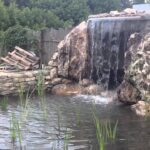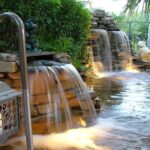Artificial waterfalls are an original and very effective element of the landscape landscape. Flowing water, overflows of light in its depths, gentle murmur and splash of a cascade on the stones create an amazing atmosphere of peace and harmony. Making a waterfall at your dacha is not so difficult, the costs are comparable to the arrangement of a pond.
Pros and cons of artificial waterfall
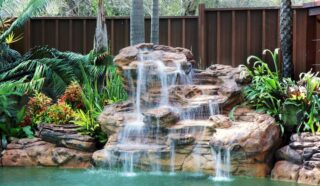
The artificial garden waterfall has many advantages:
- The water falling down the levels has the strongest calming effect. The therapeutic effect of a small cascade or fountain is higher than that of a body of water.
- An original solution in the garden landscape.
- The water cascade provides constant high humidity over a fairly large area. On the "shores" of the waterfall, you can plant moisture-loving plants. At the same time, there is no need to equip an additional irrigation system for them.
- The design of artificial cascades is simple and does not change much, but the design and dimensions can vary within a very wide range.
Minuses:
- This is an expensive piece of jewelry. To ensure sufficient water circulation, you will need to install a pump, piping, drainage system.
- If there is no natural elevation on the site, the ledges will have to be built with your own hands, and this takes time and costs.
- Caring for a waterfall is as difficult and time-consuming as for a pond.
It is believed that flowing water is purified on its own, so artificial streams, unlike fountains and ponds, do not need disinfection and cleaning. However, this is a wrong opinion.
Choosing a location for installation
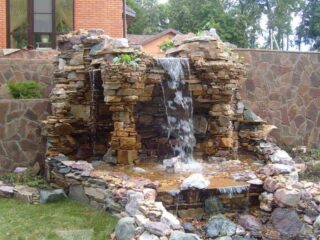
Finding the right place for your home waterfall requires a variety of factors to consider.
First of all, it is necessary to calculate the distance from residential buildings. A waterfall is a water source, and even if the water in it is not potable, it is considered precisely as a source. In relation to him, all mandatory sanitary standards apply:
- The distance from a residential building to an artificial reservoir reaches 5 m. It is allowed to reduce the distance if the site has a pronounced relief.
- From the reservoir to the toilet or septic tank should be at least 10 m.
- From a barn with animals or birds - at least 20 m, to a change house with equipment - 5 m.
The distance to trees and bushes is not standardized, since the waterfall is an element of the garden landscape.
The next factor is the relief of the country yard. The easiest way is to use the existing height difference: lay out the steps, install several stones. If there is none, a stone slide is erected in any suitable place.
They equip a waterfall in the country with their own hands on the shore of a reservoir. If it is already planned to place an artificial lake on the site, it is better to equip the waterfall there.
An important factor is the aesthetic side. Most often, a cascade or fountain is installed within sight of the house. But if the plot is large enough and the garden occupies a large area of it, it is better to place the waterfall in the back of the garden, in a recreation area.
Varieties of decorative waterfalls
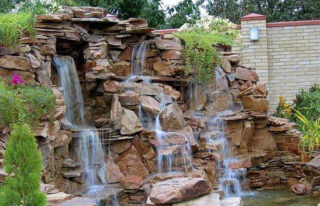
There are many decorative home waterfalls:
- Classic - as much as possible imitates a natural reservoir with several "steps" made of stone. Water flows from level to level without making a lot of noise, but emits a splash due to falling from a height.Often they are limited to some semblance of a stream descending along the slope into a lake.
- Cascading - in such a structure it is important to create a large difference in height so that the falling jet makes noise, foams and even jumps from stone to stone. This is not so difficult to achieve. The sizes of the cascade option for a country house may be different.
- Dripping down is a "quieter" model. The levels are one above the other, they look like bowls. Water flows from the upper bowl to the lower one. A waterfall like this in a small garden is the best place for meditation.
- A wall is a very effective idea, but it takes a lot of effort. Water falls in a continuous stream from a great height of at least 1.5 m into the reservoir. For the functioning of the waterfall, a large volume of water and powerful equipment will be required. A very original option is when such a "wall" is mounted directly on the wall of the house.
- Mini waterfall wall, a kind of lightweight modification. Several holes are made in the wall, from which water falls into the lake below. Often, cascades are combined with "jets" of greenery.
- The grotto is a complex structure installed in the depths of the garden. Here, a water source is placed in the depths of an artificial stone cave. The pond is designed as naturally as possible with the help of natural stone and greenery. The grotto is often illuminated, which makes this element of the garden especially beautiful.
Even the simplest waterfall or home fountain can be used in the garden. Such a device is left outside in the summer and dismantled for the winter.
Waterfall device
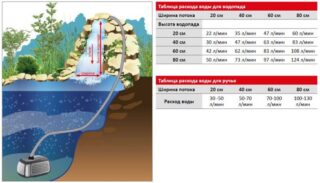
The design of any option is simple. The source of water is actually an artificial or natural body of water in the garden. The pump for supplying water is placed at the bottom of the reservoir. The water supply pipe is laid at a low height. The water taken from the pool is returned to the reservoir.
This system is not closed. Some of the water evaporates as the jets reach the pool. If for a natural reservoir such a loss is hardly noticeable, since it is fed by groundwater, then in an artificial structure this shortage must be covered.
1 jet of water requires 150–250 liters per hour. For a cascade of shroud, 400–600 liters are needed. A solid wall of water will require up to 1200 liters. A waterfall that imitates a natural one, with rolling jets, foaming, will need at least 3500 liters per hour.
A 1-stage version will spend from 2 to 5% of water on evaporation per day, that is, from 30 to 200 liters. The option of 3 jets will lose from 90 to 600 liters per day. Replenish the loss by supplying water to an artificial pool. The possibilities of the local water supply turn out to be a decisive factor in choosing a model.
DIY installation
It is not so difficult to make a waterfall with your own hands, but its maintenance will require a lot of costs. Before starting construction, you need to assess your capabilities and weigh all the factors.
Necessary materials
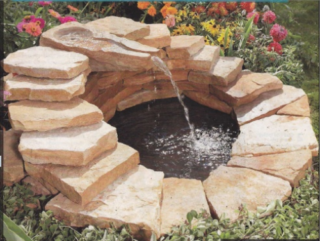
To equip an indoor or garden waterfall you will need:
- shovel, hammer, tamping device;
- tape measure, plumb line, level;
- since the basis for an artificial waterfall is a kind of concrete frame, concrete is the main construction material;
- if the concrete mix is made by themselves, a concrete mixer will also be needed;
- boards or plywood for formwork;
- pipes - plastic plumbing is better;
- pump - the device is selected according to power.
A variety of materials are used to decorate the cascade: artificial and natural stones, bricks and tuffs, glass and green plants.
Pump selection
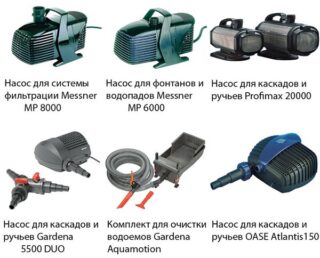
The second most important moment when building a waterfall with your own hands in the country is the choice of a pump. Its power is calculated based on the following considerations.
On average, the height of the cascade is 1 m, even if the jet falls into several bowls. Approximately an hourly flow rate is 1 cubic meter, that is, the flow is from 0.27 to 0.3 liters per second. To raise 1 liter of water to a height of 1 m, you need to do work of 1 kgf or 9.8 J.The power for 1 s in this case is 0.28 * 9.8 = 2.75 W.
The efficiency of a submersible pump is about 70%, in cheap models it is less. This means that to raise the specified volume of water, 2.75 / 0.7 * 3 = 11.8 watts are required. The value is multiplied by 5 to account for the power loss due to clogged filters. The indicator is increased by another 20%, since it is necessary to provide for voltage drops. As a result, the minimum pump power for a 1-stage waterfall with a height of 1 m will be 75 W.
In the given example, it was assumed that the length of the supply pipe does not exceed 10 m.If the value is greater, the loss coefficient becomes higher: with a length of 15 m - 4, at 20 m - 6.5, at 30 - 7.2.
Construction stages
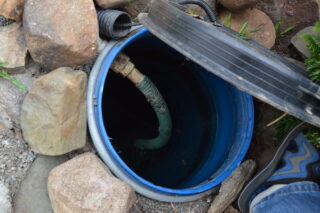
If there is a natural pond on the site, it is better to use it for the construction of cascades and waterfalls. If an artificial pool is being built, then in parallel with the arrangement of the waterfall. The step-by-step instructions are complex, but the general construction guidance is similar both when building a cascade wall and a homemade pond from a bathroom.
- Dig a trench under the pond. Its dimensions must also be calculated taking into account the capabilities of the water supply system. The bottom is reinforced, usually concreted.
- Steps are built on one side of the pond. If there is no natural elevation next to the reservoir, a slide is built from the excavated soil and steps are formed in it.
- Formwork is installed on them and poured with concrete.
- After the material has completely dried, water pipes are laid: for supplying water to the cascade, for supplying water to the pool and for drainage.
- Decorate the bottom and steps in the chosen way.
- Pour water into the pool, install and connect the pump. Water should not be supplied under high pressure; an equilibrium must be maintained between the volume of the supplied and received liquid.
Then the plants are planted on the banks of the pond. Decorate the waterfall on the site with moss and lichen.
Arrangement and decoration
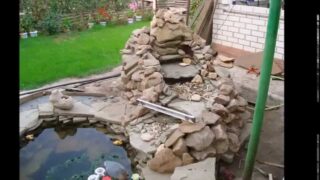
How to make and decorate a waterfall depends on the chosen landscape. The decor is the most varied:
- Natural - for example, in an English or Japanese garden, a cascade and a pond should look as natural as possible. For decoration, they take cobblestones overgrown with moss, pebbles and rubble, and plant shrubs and grasses on the shore. The pond with water lilies is very romantic.
- Rustic - decoration includes a thin vine fence, clay figurines of birds, jugs. Stones are taken more homogeneous, more flowering plants are planted.
- The modern design is austere. The steps here have emphatically geometric regular shapes, the outlines of the pool are far from natural. Flowers are usually planted around the waterfall, and lights are mounted at the bottom of the pond;
- The French version prefers a waterfall in the form of jets flowing from bowl to bowl. Such a cascade and a pond have beautiful marble sides, neatly trimmed bushes grow around the reservoir. The best decor is marble and clay figurines of nymphs and fauns.
A waterfall made of stones and concrete with your own hands is an extremely effective and beautiful solution. This addition to the landscape gives the garden sophistication and harmony.

